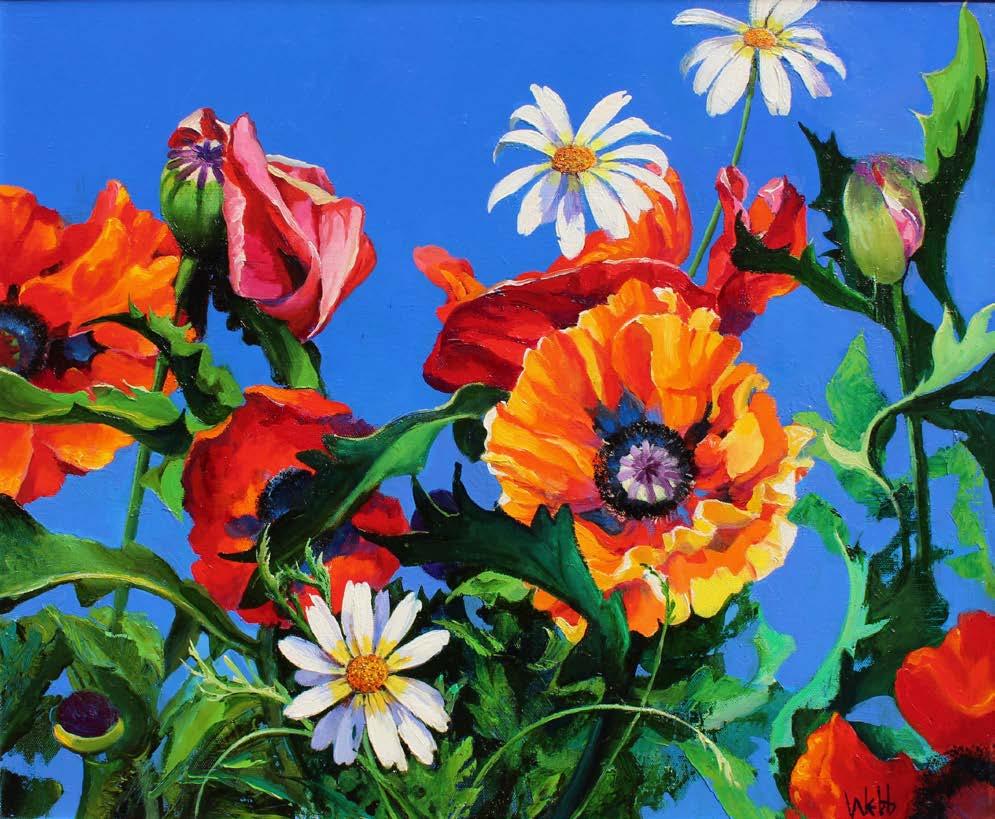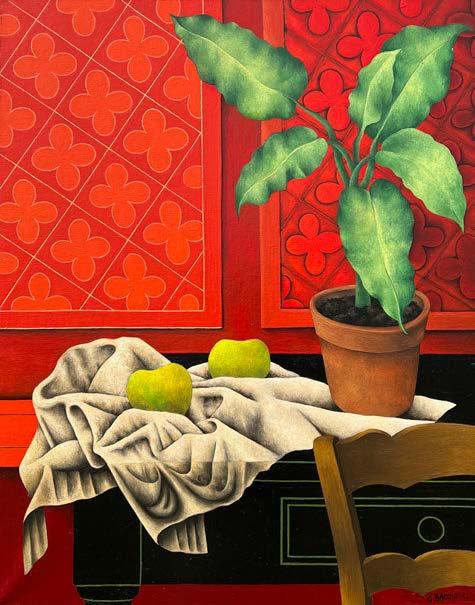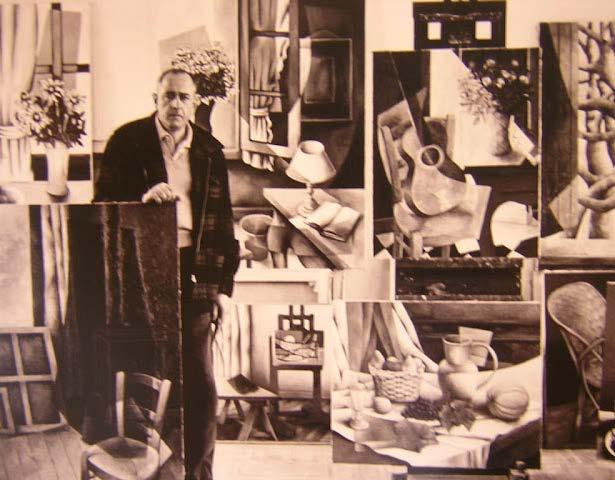
4 minute read
Kenneth Webb
Irish, (Contemporary)
Kenneth Webb is considered to be one of the finest landscape painters of the last one-hundred years. Over the course of his career, Kenneth’s landscape painting has evolved through several significant phases over his many decades of painting - in terms of both subject and technique, and today he continues to create and innovate through his art.
Kenneth has spent his life creating spectacular paintings so that we might share his own individual reaction and impression to the natural world around us. Kenneth’s paintings are an exploration and celebration of the natural world through colour. Experimenting with colour in a free, expressionist manner since his art school years, Kenneth has arrived at a joyous aesthetic that captivates and envelops the viewer. Taking inspiration from the natural landscape around him, from his garden and his studio in Connemara on the west coast of Ireland, his paintings are rooted in place and are deeply personal.
From vibrant, attention grabbing poppies to ethereal waterlilies, Kenneth has always sought out the beauty in the natural world that surrounds him. From the south coast of Devon to the rugged landscape of Connemara, Kenneth’s artistic milieu has enabled him to constantly evolve and reimagine his subjects.
Despite their range, none of these themes has been entirely isolated or completed; Kenneth continually revisits subjects and techniques, adapting his approach and combining ideas in his eternal quest to truly capture the mood, the emotion - the spiritual essence - of a landscape.
Over the course of Kenneth’s lengthy artistic career, he has shown works at numerous notable institutions, including the Royal Academy in London. Kenneth founded the Irish School of Landscape painting in 1957 and has since lectured at the Tate Gallery, Victoria and Albert Museum and the National Gallery in London.
Kenneth’s paintings are celebrated and collected internationally, with his work placed in prestigious collections across the world. Gladwell & Patterson have represented Kenneth Webb in London since 2010 and in that time his monumental works have found fame with important collectors in China, America and the United Kingdom.
Georges Bauquier
French, (1910-1997)
Nature Morte aux Deux Pommes, No. 5
Oil on Canvas

92 x 73 cms / 36” x 29”
Provenance
Studio of Georges Bauquier, France.
Private Collection, France; acquired from the above. Gladwell & Patterson, London; acquired in March 2022.
Exhibitions
Cannes, La Malmaison, Georges Bauquier : Natures Mortes à la Fenêtre, December 2002 – February 2003, (reproduced on page 53 of the catalogue.
Vascoeuil, Château de Vascoeuil, Georges Bauquier 1910 – 1997 : Paintings – Gouaches – Drawings, March to June 2005.
Bauquier’s Nature Morte aux Deux Pommes, No. 5 was painted in the middle of the artist’s mature phase. One of a series of still lifes, all of which bear an identical title, the paintings in this series all reiterate similar motifs; two apples positioned on top of a gathered table cloth within a striking interior backdrop. Vibrant wall paper, as in the present work features heavily throughout this series adding to the depth and drama of each composition.
Larger in size than most of the painter’s output, Bauquier clearly saw these pieces as emblematic of his style. Strongly structured and vividly coloured, the artist balances his cubist roots with his personal love of expressive colouration. From the beginning of the 1960s, when Bauquier had begun to truly move out of Léger’s shadow, his work had begun to assume the characteristics we find in Nature Morte aux Deux Pommes, No. 5 ; an interior still life spread across large surfaces of colour.
Nature Morte aux Deux Pommes, No. 5 is most interesting for its return to a central motif for the painter: foliage. Many of the artist’s earliest works concern themselves with plants and trees reaching outwards and spreading their leaves, an analogy to his growing artistic independence, yet as the artist more confidently adopted his own style of still lives these vignettes began to disappear. Nature Morte aux Deux Pommes, No. 5 therefore represents a far more biographical composition than is commonly seen in his work: synthesising his personal late style with a memory of his early years working with Léger.

Georges Bauquier French, (1910-1997)
Georges Bauquier’s career is defined by his intimate personal and professional relationship with the great Cubist master, Fernand Léger. For twenty years the two painters worked closely together, and after Léger’s death Bauquier would be instrumental in both founding a museum dedicated to the artist and writing his eight volume Catalogue Raisonné.
Crucially, despite effectively remaining in Léger’s shadow until the older painter’s death in 1955, Bauquier was able to create his own synthesis of Cubism, creating a personal style that combined Léger, Braque and Cézanne for which he is increasingly lauded.
As the French critic Tabaraud notes:
“It cannot appear easy to be, for the twenty years from 1936 to his death, both the friend and closest daily collaborator of Fernand Léger and still pursue autonomous pictorial research, yet through constant study in the secrecy of the studio Bauquier was still able to find a personal identity.”
Born in 1910 in Nîmes, Bauquier would decide to become an artist in his early twenties, enrolling the School of Fine Arts in Paris in 1934, where received a first-rate classical education in draughtsmanship. However, after becoming increasingly dissatisfied at the constraints of academic painting, Bauquier would join the School of Contemporary Art in 1936, where he immediately began to work closely under, Fernand Léger, who the School’s director.
During the Second World War where the young artist joined the Communist Party and French Resistance, which culminating in a period of imprisonment by Nazi occupiers. Upon release, he reunited with Léger. During the following decade the two artists would work together daily; so close was Bauquier’s relationship with Léger, that after the latter’s death in 1955 he married Léger’s widow, Nadia. Alongside his wife, Bauquier immediately set about creating a museum to celebrate Léger’s life, which they opened in 1960 and would subsequently furnish with 348 works by Léger.
Bauquier’s personal style would develop quickly, and while he often declined to publicise his output, his exhibitions in the early 1950s were prefaced by Léger and saw great success in Paris. His works are usually predicated on a balance between great colouristic freedom and maintaining rigid compositional principles which he had learned from his teacher. Bauquier’s best known pieces are his still lifes, which occupy bold, often Cubist-inspired interiors, and frequently feature the artist’s favoured motif, a single piece of vegetation.






